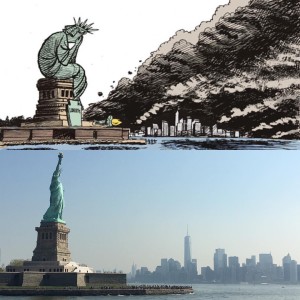 To mark my 20th year of being a cartoonist in Mississippi, I thought I’d dig out 20 tales from the past two decades. Some are funny. Some are serious. All tell the story of how I came to fall in love with this sometimes frustrating but always fascinating state we live in.
To mark my 20th year of being a cartoonist in Mississippi, I thought I’d dig out 20 tales from the past two decades. Some are funny. Some are serious. All tell the story of how I came to fall in love with this sometimes frustrating but always fascinating state we live in.
A chilled wind blew in off the steel gray Mississippi sound. Civilization was offline; destruction stretched from horizon to horizon. Hurricane Katrina had visited in August. And her wrath still was being dealt with in December. As you traveled down the beach, you could see residents living in tents. FEMA trailers had begun pop up like formaldehyde-tainted mushrooms.
Debris marked the spot of broken dreams and lives. Cold rain fell from the sky.
Earlier in the day, I had stood on a compromised roof, installing a tarp as three Pit Bull Terriers placed bets on when I’d fall. I was volunteering with Camp Coast Care and helping people get their lives back. The group I was working with quickly fixed the roof and headed to our next assignment — one that was a bit unusual.
We were searching for a ring.
The house we stopped at was the last house destroyed by Katrina’s record-setting storm surge. Water had unexpectedly caught the owners by surprise and they had to evacuate quickly. A precious wedding ring was left behind.
Our mission? To find the proverbial needle in the haystack of debris. Looking at the debris, it seemed like a hopeless mission. But we were there in the name of God. And it would take a miracle to find it.
Down the street was a 1960’s Chevrolet pickup next to a more modern Toyota RAV4. The Toyota was crushed like a PBR beer can — never underestimate the power of water. But the truck was as recognizable as it was rusty. I asked the owner of the house if it had been his truck (he collected WW2 memorabilia and had an old, now destroyed, Willy’s Jeep.)
“No,” he said. “It got sucked out during Camille and brought back by Katrina.”
What the Sound taketh, it giveth back.
Later in the afternoon, we were taking a break after digging through he muck. I pointed to a white pickup truck across the street.
“What happened to them?” I asked.
The truck was where the carport used to be. The rest of the house was gone.
“They stayed,” he paused and then continued, “and drowned. Four people behind them did, too.”
Within 90 yards, six souls had been lost.
We continued to dig through the muck. We’d find little pieces of his life. His daughter’s swim team ribbon. An old picture. Like Portkeys in Harry Potter, each item took him on a journey to a memory.
“This is nuts,” one of the other volunteers said exasperated.
I said, “No, we’re down here in Christ’s name. We’re helping him heal.”
We were. The volunteers on the Gulf Coast were religion’s finest moment. It’s when people took what was in the Good Book and put it to practice.
Evening fell and we packed up. The ring remained hidden. The smell of death still wafted through the air. A cold drizzle dampened a frazzled American flag.
Ten years later, I returned to the same spot. The owner of the house had rebuilt a concrete palace on pillars. The Mississippi Sound could taunt the land again — but the house would stand this time. I walked up the stairs and knocked on door. The owner opened up and I introduced myself. I showed him the pictures I had drawn from that day and he told me about his last ten years, the insurance battles and his desire to move on. I didn’t blame him.
As I started to leave, I turned and asked him, “Did you ever find the ring.”
He smiled and said, “Yes. About a week after you left.” I volunteer had sunk a shovel into the muck and found it.
Right in the middle of the worst disaster to hit the Mississippi Gulf Coast, a minor miracle had taken place. Faith was rewarded.
It was a ring of truth.



